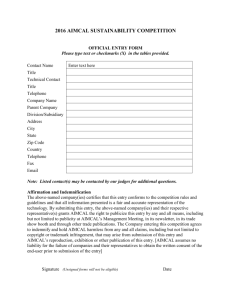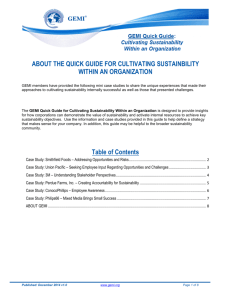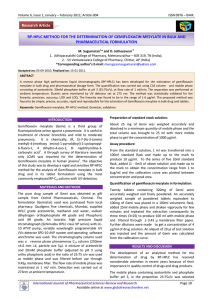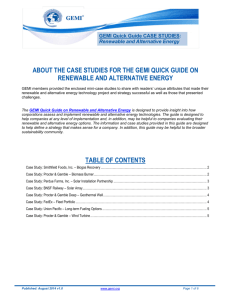What are the Characteristics of a Learning Organization?
advertisement
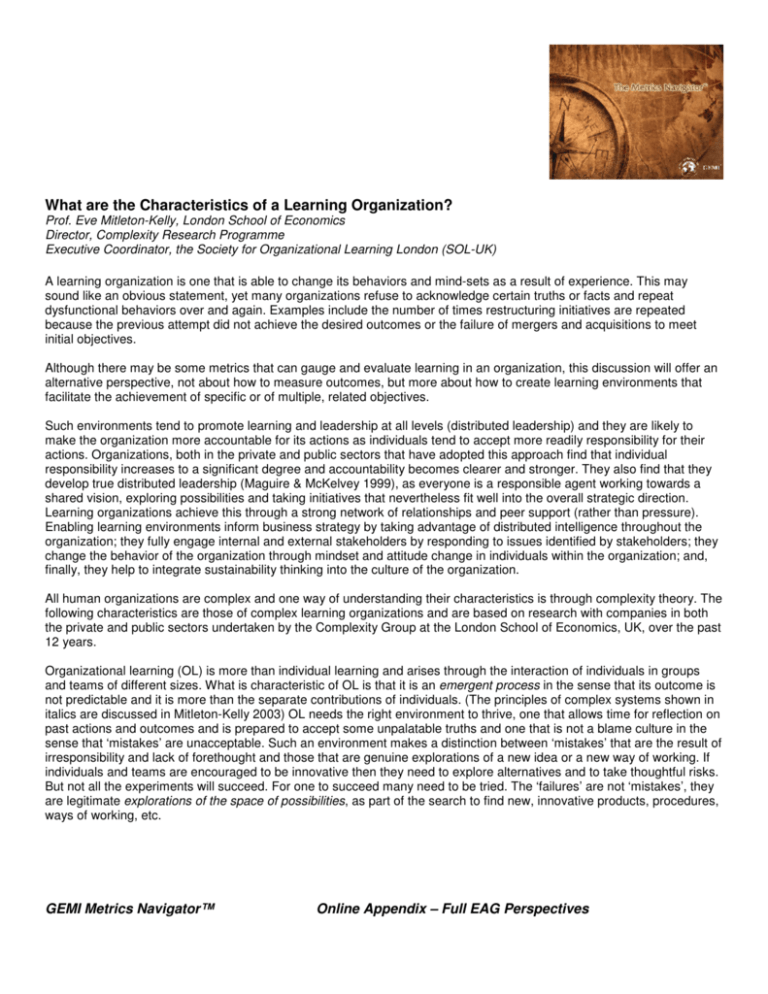
What are the Characteristics of a Learning Organization? Prof. Eve Mitleton-Kelly, London School of Economics Director, Complexity Research Programme Executive Coordinator, the Society for Organizational Learning London (SOL-UK) A learning organization is one that is able to change its behaviors and mind-sets as a result of experience. This may sound like an obvious statement, yet many organizations refuse to acknowledge certain truths or facts and repeat dysfunctional behaviors over and again. Examples include the number of times restructuring initiatives are repeated because the previous attempt did not achieve the desired outcomes or the failure of mergers and acquisitions to meet initial objectives. Although there may be some metrics that can gauge and evaluate learning in an organization, this discussion will offer an alternative perspective, not about how to measure outcomes, but more about how to create learning environments that facilitate the achievement of specific or of multiple, related objectives. Such environments tend to promote learning and leadership at all levels (distributed leadership) and they are likely to make the organization more accountable for its actions as individuals tend to accept more readily responsibility for their actions. Organizations, both in the private and public sectors that have adopted this approach find that individual responsibility increases to a significant degree and accountability becomes clearer and stronger. They also find that they develop true distributed leadership (Maguire & McKelvey 1999), as everyone is a responsible agent working towards a shared vision, exploring possibilities and taking initiatives that nevertheless fit well into the overall strategic direction. Learning organizations achieve this through a strong network of relationships and peer support (rather than pressure). Enabling learning environments inform business strategy by taking advantage of distributed intelligence throughout the organization; they fully engage internal and external stakeholders by responding to issues identified by stakeholders; they change the behavior of the organization through mindset and attitude change in individuals within the organization; and, finally, they help to integrate sustainability thinking into the culture of the organization. All human organizations are complex and one way of understanding their characteristics is through complexity theory. The following characteristics are those of complex learning organizations and are based on research with companies in both the private and public sectors undertaken by the Complexity Group at the London School of Economics, UK, over the past 12 years. Organizational learning (OL) is more than individual learning and arises through the interaction of individuals in groups and teams of different sizes. What is characteristic of OL is that it is an emergent process in the sense that its outcome is not predictable and it is more than the separate contributions of individuals. (The principles of complex systems shown in italics are discussed in Mitleton-Kelly 2003) OL needs the right environment to thrive, one that allows time for reflection on past actions and outcomes and is prepared to accept some unpalatable truths and one that is not a blame culture in the sense that ‘mistakes’ are unacceptable. Such an environment makes a distinction between ‘mistakes’ that are the result of irresponsibility and lack of forethought and those that are genuine explorations of a new idea or a new way of working. If individuals and teams are encouraged to be innovative then they need to explore alternatives and to take thoughtful risks. But not all the experiments will succeed. For one to succeed many need to be tried. The ‘failures’ are not ‘mistakes’, they are legitimate explorations of the space of possibilities, as part of the search to find new, innovative products, procedures, ways of working, etc. GEMI Metrics Navigator™ Online Appendix – Full EAG Perspectives What are the Characteristics of a Learning Organization? (Continued) During the learning process, individuals will influence each other and their ideas will co-evolve; that is each idea will adapt and change in the context of other ideas, and once changed, it will, in turn, have an influence on what happens next. The concept of co-evolution is a powerful one and applies not only to internal organizational learning but also to strategy in relation to a changing environment, as well as to sustainability understanding. Whatever actions or procedures are in place at any one time regarding sustainability (whether organizational or environmental) they cannot remain static. As the broader environment changes these actions and procedures, policies, etc., need to change to respond to changes in the environment. Once changed, they will, in turn, influence that broader environment. When the influence and change are reciprocal and not unilateral then co-evolution has occurred. In terms of sustainability, the concept to work towards is that of co-evolutionary sustainability – in other words the ability of an organization to continuously and appropriately adapt to external changes in its broader environment. Another relevant concept, inspired by biology, is the notion of the social ecosystem. This includes all competitors, suppliers, customers, associates, legal and government bodies, etc. Complexity theory sees systems as interacting wholes, influencing each other, in a co-evolutionary process. Learning organizations encourage self-organization, so that groups can come together to explore new ideas without being directed to do so by a manager outside that group. This is the process that occurs naturally around the coffee machine or the water cooler, but learning organizations actively encourage self-organization and do not see it as a waste of time. This is an essential part of the innovative process which is also an integral part of creating an environment that facilitates coevolutionary sustainability. Organizations include multiple and intricate networks of relationships, which are sustained through communication and other forms of feedback, with varying degrees of inter-dependence. Although heavily influenced by their history and culture, they can transcend both when necessary. When such organizations meet a constraint they are able to explore the space of possibilities and find a different way of doing things, i.e., they are creative and innovative and can create something new. This creation of new order is the distinctive characteristic of complex (as distinct from complicated) systems. Unfortunately, this innate source of innovation is often restricted. Understanding the characteristics of complex systems and of complex learning organizations means that we can work with those characteristics to achieve objectives, rather than against them. For papers describing the theory, methodology and case studies please see Publications in www.lse.ac.uk/complexity Maguire S. & McKelvey B. 1999 ‘Complexity and Management: Moving from Fad to Firm Foundations’ Emergence, 1(2), 1999, 19-61 Mitleton-Kelly E. 2003 ‘Ten Principles of Complexity & Enabling Infrastructures’ in ‘Complex Systems & Evolutionary Perspectives of Organisations: The Application of Complexity Theory to Organisations’, Elsevier, ISBN 0-08-043957-8 GEMI Metrics Navigator™ Online Appendix – Full EAG Perspectives








